
Encourage children to play together with LEGO

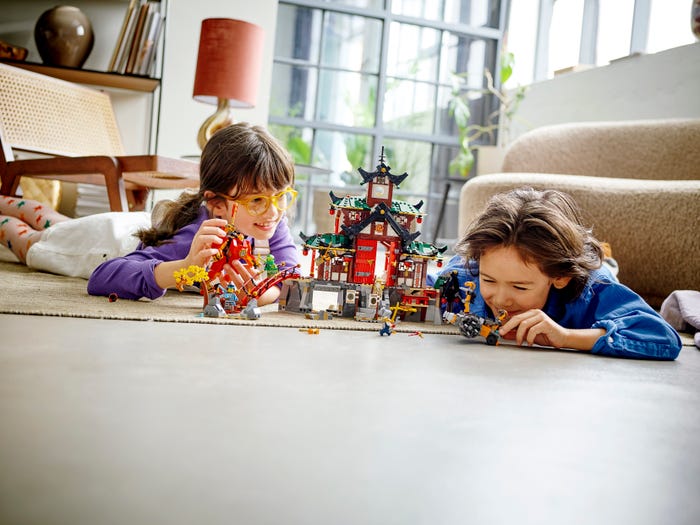
What are the benefits of cooperative play?
Children benefit from cooperative play with other children and adults because it helps them learn about the needs of other people and develops important communication and empathy skills. Let's take a closer look at the main benefits of cooperative play.
Children who work together can communicate better
Cooperative basically means working with others. Children quickly learn that collaboration only works if they communicate well. This means that children who work together learn to express themselves clearly and convey what they mean, while at the same time processing information from their environment and from their playmates. As children's communication skills improve, they come to understand why it is important to listen to others, respect each other, and put themselves in other people's shoes.Children who work together are better at resolving conflicts
From birth, children receive love, affection and attention from their parents. At home and in the family, everyone is completely focused on the child, so it is understandable that they come to believe that everything revolves around them. Adults know better, but it can take some time for children to learn that everyone is the same in this regard and just the same. important as themselves. Through cooperative play, children learn to share toys and wait their turn. As children become more accustomed to these ideas, they quickly begin to see the effort their friends make to achieve the same goal. Once they realize this, they develop respect for it and eventually this turns into trust. Forming such relationships and developing cooperative skills helps them resolve conflicts: they come to understand the value of cooperation and why it is important.Children who work together learn how to solve problems
Cooperative play not only helps children to better deal with conflicts, but also to solve problems. When children work together, they discuss what to do and try to find the best solution together. As children improve their communication skills and learn to respect other views, they also develop the ability to approach a problem from different perspectives.Children who work together learn to deal with their emotions
Working together in a team can be emotional. It is very exciting when you win or achieve your goal, but when the opposite happens it can be disappointing. Children often have difficulty dealing with this mix of emotions. It's overwhelming to process so many feelings at once. When children experience such emotions in a cooperative environment, they learn how to cope with them and regulate their feelings and behavior.Children who work together find their place in the world
By working together, children come into contact with the foundations of social structures and discover their place within them. When children play together, they develop understanding and affection for other people while making friends they trust and respect. This allows children to better develop a sense of selflessness: they notice and recognize that everyone has their own needs, wishes and feelings. As this understanding grows, they learn how to help others and realize how nice it is to do something good.Examples of cooperative play and activities for toddlers (1.5 to 3 years old)
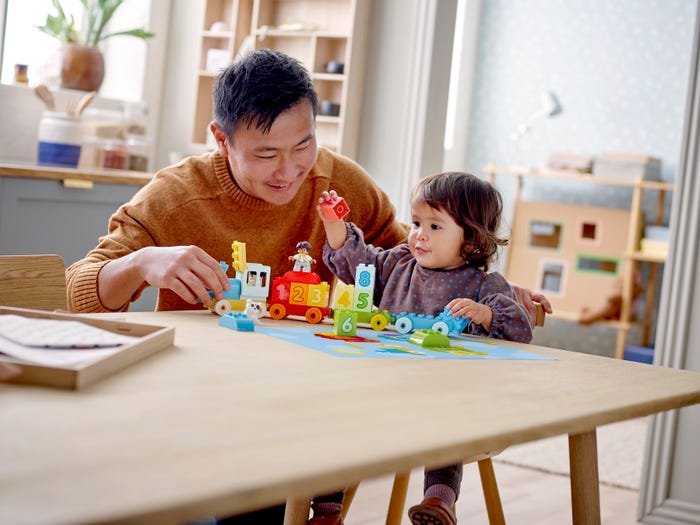
Puzzle together
Solving a puzzle can be a wonderful way for young children to work together toward a common goal. Whether your child is putting together the pieces of an age-appropriate jigsaw puzzle, arranging numbers and letters from toys or solving puzzles, they learn to work together by solving problems.follow the leader
A very simple and fun game for toddlers is 'Follow the Leader', where they walk around the house, room or garden. The idea is for the leader to come up with new actions, such as jumping, hopping or waving their arms, and for the followers to imitate this. With this simple game, children learn that there are times when they have to follow and times when they decide what happens. They also learn to be patient and wait for their turn.Make a maze
With the right tools, such as LEGO® DUPLO® building toys and sets, can toddlers from 18 months old build and solve a maze together. They use DUPLO bricks to build the walls of the maze. Once they are done, they place a ball in the maze. By lifting and tilting the building plate together, they move the ball through the maze. Only with teamwork will it be possible to get the ball rolling in the right direction. If children need help, ask a specific question, such as "What happens if you lower the plate on the left?" This encourages them to respond proactively and solve the problem themselves. By encouraging children to take control and try a different approach, their confidence grows and they learn that a problem can have different solutions.Building stories
Get children together and let them make up a story. This is a great method to stimulate their imagination and get them to work together in a fun and entertaining way. You can do this with colored pencils and paper or with sets. First ask one of the children to draw or build something with the materials available. This could be a person, a house, a flower or an animal. When the child is ready, give the second child a similar assignment. The children create something together and keep adding something while they come up with a story together around their creation.SHOP LEGO DUPLO >>>
Playing with dolls
Puppets are wonderful for introducing young children to role-playing games. You can use all kinds of different things as dolls, such as socks, shadows, folded pieces of paper with faces drawn on them and even LEGO® DUPLO® figures. Because all the colored bricks and parts are designed for little hands, children can easily make up and act out a story with the many funny figures. It doesn't matter whether children tell a story with dolls or have the dolls do a crazy dance to music. When they play with dolls, they work together to make the dolls come alive.Examples of cooperative play and activities for preschoolers aged 4 and 5 years old
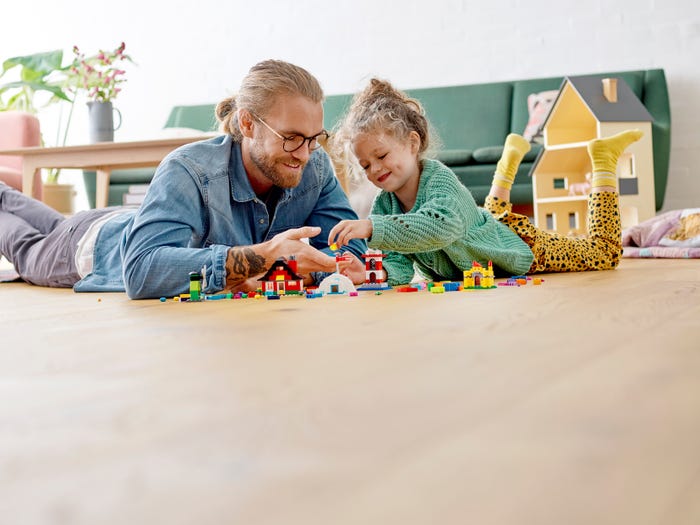
Building together
Building something together, whether it's a fortress of pillows and cardboard boxes or a tower of LEGO® Classic bricks, requires negotiation, teamwork and compromise. You can easily encourage children from the age of 4 to work together by challenging them to build the highest tower or the longest snake. Kids can also work together by building larger LEGO® sets with instructions. Remember that following rules, knowing how to share, and waiting for your turn is a more complex form of cooperation than free play.Encourage role-playing
Reenacting specific situations places great demands on children's cooperation skills. Maybe they act out situations from everyday life, such as going to the store or cooking together in a play kitchen. They take turns taking on different roles and learning how to be responsible for tasks together. Many LEGO® sets can further stimulate their imagination and provide new ideas for role-play. By taking on the role of people they rarely come into contact with in real life, children improve their empathy and can better empathize with others.Examples of cooperative play and activities for children aged 6 to 8 years old
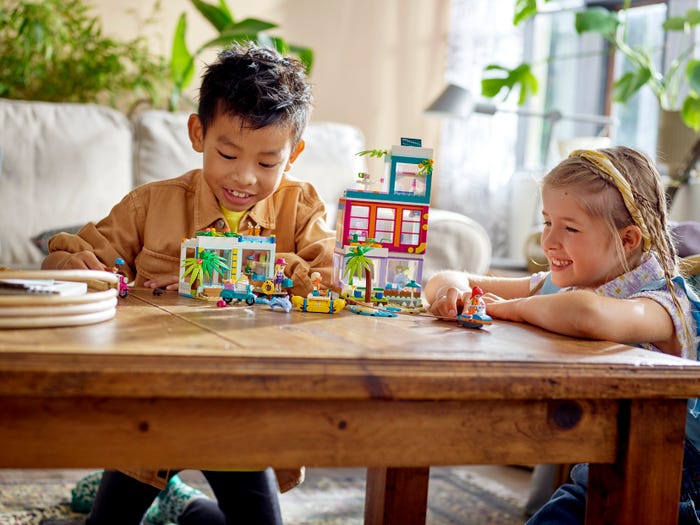
Games
Games don't always have to be about winning and losing, but can also be cooperative. For example, when children hunt for treasure, they must work together to achieve a common goal. While competitive games are important for developing certain skills, cooperative games teach children that cooperation and mutual respect are important skills and valued in the wider society.Making art together
If you give children the opportunity to build their own work of art together, you encourage cooperative play. Give your children a large sheet of paper for a drawing or mural, or look for branches from the forest together and decorate your house.
Making music together
Get children together and let them create their own symphony. This is also a wonderful way to make something together while experimenting with instruments and different sounds. Experimenting with instruments and being loud is fun, but really making music together means following certain rules. When children practice and learn how to play a new song together, they have fun when they succeed and appreciate each other's efforts.TOP LEGO SETS FOR ROLE PLAYING: LEGO CITY. SHOP NOW >>>
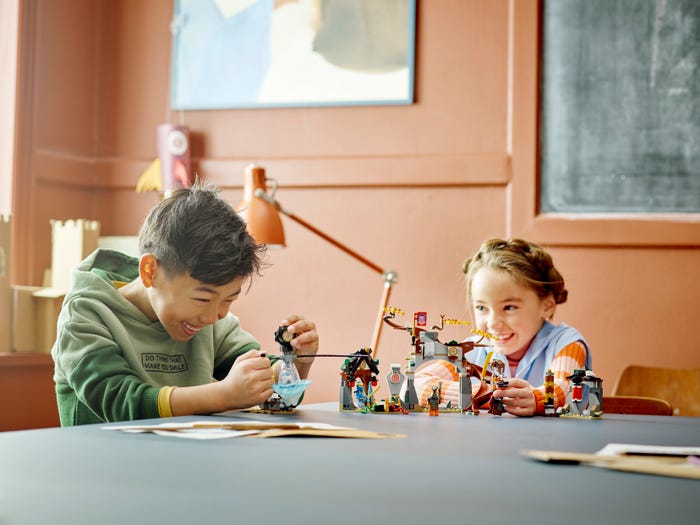
While children learn most collaboration skills in early childhood, they can continue to improve these skills with activities that involve interacting with others in a team environment.
Participate in team activities and competitions
There are many types of clubs that children can participate in, such as STEM clubs, programming and computer clubs and also sports clubs. At all clubs, children learn how to become better team players and how to communicate with others. There are also schools with a LEGO® club where children build something together.
Sharing responsibilities at home
It is important that older children take over tasks such as chores and helping around the house, whether they are doing the dishes or washing clothes. This teaches them to take responsibility and how to keep the house in order together with the rest of the family. It really doesn't matter what stage of life your child is in, it's never too early or too late to encourage cooperation. Cooperative play helps with this.-
LEGO Helmets
READ MORE -

What is the difference between LEGO and DUPLO
READ MORE -
LEGO Powerfunctions and Powered-Up
READ MORE -
Why choose 2TTOYS LEGO store?
READ MORE -
Formula 1 cars from LEGO
READ MORE -

The nicest LEGO Farm sets
READ MORE -

The most beautiful LEGO cars for real drivers and collectors!
READ MORE -

How is LEGO tested for safety?
READ MORE -
LEGO Jurassic World Dino
READ MORE
LATEST LEGO SETS
-
LEGO Mateo's Off-Road Car 71471 Dreamzzz
Regular price €8,49 EURRegular priceUnit price / per€9,99 EURSale price €8,49 EURSale -
LEGO Expansion Set: Bowser's Car 71431 Super Mario
Regular price €25,49 EURRegular priceUnit price / per€29,99 EURSale price €25,49 EURSale -
LEGO Expansion Set: Yoshi's Peculiar Forest 71428 SuperMario
Regular price €8,49 EURRegular priceUnit price / per€9,99 EURSale price €8,49 EURSale -
LEGO Space Base and Rocket Launch Pad 60434 City
Regular price €147,49 EURRegular priceUnit price / per€139,99 EURSale price €147,49 EUR -
LEGO Modular Space Station 60433 City
Regular price €84,98 EURRegular priceUnit price / per€99,99 EURSale price €84,98 EURSale -
LEGO Mining Asteroids in Space 60429 City
Regular price €16,49 EURRegular priceUnit price / per€19,99 EURSale price €16,49 EURSale -
LEGO Prison Island Police Station 60419 City
Regular price €84,49 EURRegular priceUnit price / per€0,00 EURSale price €84,49 EUR -
LEGO Police Car and Muscle Car Chase 60415 City
Regular price €16,49 EURRegular priceUnit price / per€19,99 EURSale price €16,49 EURSale -
LEGO Fire Station with Aerial Ladder Vehicle 60414 City
Regular price €67,49 EURRegular priceUnit price / per€79,99 EURSale price €67,49 EURSale -
LEGO Fire Department Helicopter 60411 City
Regular price €8,49 EURRegular priceUnit price / per€9,99 EURSale price €8,49 EURSale -
LEGO Race Car Transporter 60406 City
Regular price €24,99 EURRegular priceUnit price / per€29,99 EURSale price €24,99 EURSale -
LEGO Rescue Helicopter 60405 City
Regular price €16,48 EURRegular priceUnit price / per€19,99 EURSale price €16,48 EURSale -
LEGO Burger Truck 60404 City
Regular price €16,49 EURRegular priceUnit price / per€19,99 EURSale price €16,49 EURSale -
LEGO Ambulance & Snowboarder 60403 City
Regular price €16,49 EURRegular priceUnit price / per€19,99 EURSale price €16,49 EURSale -
LEGO Steamroller 60401 City
Regular price €8,49 EURRegular priceUnit price / per€9,99 EURSale price €8,49 EURSale -
LEGO Green Race Car 60399 City
Regular price €8,49 EURRegular priceUnit price / per€9,99 EURSale price €8,49 EURSale -
LEGO Princess Market Visit 43246 Disney
Regular price €84,98 EURRegular priceUnit price / per€99,99 EURSale price €84,98 EURSale -
LEGO Belle's Belle's Horse Carriage 43233 Disney
Regular price €13,49 EURRegular priceUnit price / per€15,99 EURSale price €13,49 EURSale -
LEGO Horse and pony trailer 42634 Friends
Regular price €16,48 EURRegular priceUnit price / per€19,99 EURSale price €16,48 EURSale -
LEGO Hot Dog Food Truck 42633 Friends
Regular price €24,99 EURRegular priceUnit price / per€29,99 EURSale price €24,99 EURSale -
LEGO Farm Vet 42632 Friends
Regular price €24,98 EURRegular priceUnit price / per€29,99 EURSale price €24,98 EURSale -
LEGO Heartlake City Hospital 42621 Friends
Regular price €84,49 EURRegular priceUnit price / per€99,99 EURSale price €84,49 EURSale -
LEGO Olly and Paisley's Houses 42620 Friends
Regular price €84,49 EURRegular priceUnit price / per€99,99 EURSale price €84,49 EURSale -
LEGO Pop star music bus 42619 Friends
Regular price €71,99 EURRegular priceUnit price / per€84,99 EURSale price €71,99 EURSale -
LEGO Farm Animal Care 42617 Friends
Regular price €46,48 EURRegular priceUnit price / per€54,99 EURSale price €46,48 EURSale
SELECTED FOR YOU
-
LEGO Statue of Liberty 21042 Architecture
Regular price €84,99 EURRegular priceUnit price / per€99,99 EURSale price €84,99 EURSale -
LEGO Paris with Eiffel Tower 21044 Architecture
Regular price €42,49 EURRegular priceUnit price / per€49,99 EURSale price €42,49 EURSale -
LEGO Trafalgar Square London 21045 Architecture
Regular price €99,99 EURRegular priceUnit price / per -
LEGO The Singapore Skyline 21057 Architecture
Regular price €49,99 EURRegular priceUnit price / per€59,99 EURSale price €49,99 EURSale -
LEGO Pyramid of Giza 21058 Architecture
Regular price €118,98 EURRegular priceUnit price / per€139,99 EURSale price €118,98 EURSale -
LEGO Syndney Opera House 10234 Creator Expert
Regular price €429,99 EURRegular priceUnit price / per -
LEGO Tower Bridge from London 10214 Creator Expert
Regular price €449,99 EURRegular priceUnit price / per -
LEGO Taj Mahal India 2017 Version 10256 Creator Expert
Regular price €449,99 EURRegular priceUnit price / per -
LEGO Las Vegas Skyline 21047 Architecture
Regular price €129,99 EURRegular priceUnit price / per -
LEGO Build your own Architecture buildings with this set Studio 21050 Architecture
Regular price €449,99 EURRegular priceUnit price / per -
LEGO The White House 21054 Architecture
Regular price €109,99 EURRegular priceUnit price / per -
LEGO Washington Lincoln Memorial 21022 Architecture (USED)
Regular price €69,99 EURRegular priceUnit price / per -
LEGO The New York Skyline 21028 Architecture (USED)
Regular price €29,99 EURRegular priceUnit price / per€39,99 EURSale price €29,99 EURSale -
LEGO The Eiffel Tower from LEGO 21019 Architecture (USED)
Regular price €49,99 EURRegular priceUnit price / per -
LEGO London Skyline 21034 Architecture
Regular price €34,98 EURRegular priceUnit price / per€39,99 EURSale price €34,98 EURSale -
LEGO The New York Skyline 21028 Architecture
Regular price €42,48 EURRegular priceUnit price / per€49,99 EURSale price €42,48 EURSale -
LEGO Himeji Castle 21060 Architecture
Regular price €134,48 EURRegular priceUnit price / per€159,99 EURSale price €134,48 EURSale -
LEGO Pyramid of Giza 21058 Architecture (USED)
Regular price €84,99 EURRegular priceUnit price / per€139,99 EURSale price €84,99 EURSale -
LEGO London Skyline 21034 Architecture (USED)
Regular price €29,99 EURRegular priceUnit price / per€39,99 EURSale price €29,99 EURSale -
LEGO Seattle Space Needle 21003 Architecture (USED)
Regular price €44,99 EURRegular priceUnit price / per -
LEGO Notre-Dame Cathedral 21061 Architecture
Regular price €64,99 EURRegular priceUnit price / per -
LEGO Solomon R. Guggenheim Museum 21004 Architecture (USED)
Regular price €74,99 EURRegular priceUnit price / per -
LEGO Farnsworth House 21009 Architecture (USED)
Regular price €99,99 EURRegular priceUnit price / per -
LEGO Louvre 21024 Architecture (USED)
Regular price €84,99 EURRegular priceUnit price / per -
LEGO Berlin 21027 Architecture (USED)
Regular price €149,99 EURRegular priceUnit price / per
-

LEGO Avatar
LEGO Avatar: Dive into the wonderful world of Pandora! Build with Jake...
-

LEGO Icons
Relive your childhood with LEGO Icons sets, specially designed for nostalgic adults....
-

LEGO Classic
Discover endless building fun with LEGO Classic sets! This collection offers a...


































































































